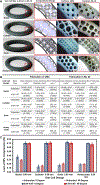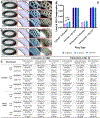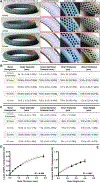Design and Characterization of a Novel Series of Geometrically Complex Intravaginal Rings with Digital Light Synthesis
- PMID: 33072856
- PMCID: PMC7567335
- DOI: 10.1002/admt.202000261
Design and Characterization of a Novel Series of Geometrically Complex Intravaginal Rings with Digital Light Synthesis
Abstract
Intravaginal rings (IVRs) represent a sustained-release approach to drug delivery and have long been used and investigated for hormones and microbicides delivery. For decades, IVRs have been manufactured by injection molding and hot-melt extrusion with very limited design and material capabilities. Additive manufacturing (AM), specifically digital light synthesis (DLS), represents an opportunity to harness the freedom of design to expand control and tunability of drug release properties from IVRs. We report a novel approach to IVR design and manufacturing that results in geometrically complex internal architectures through the incorporation of distinct unit cells using computationally-aided design (CAD) software. We developed a systematic approach to design through the generation of an IVR library and investigated the effects of these parameters on ring properties. We demonstrate the ability to precisely and predictably control the compressive properties of the IVR independent of the internal architecture with which control of drug release kinetics can be achieved, thus opening the door for a 'plug-and-play' platform approach to IVR fabrication.
Keywords: 3D printing; Intravaginal rings (IVRs); computationally-aided design (CAD); digital light synthesis; lattice.
Conflict of interest statement
Conflict of Interest Disclosure. S.R.B and R.J. are inventors on a patent describing geometrically complex intravaginal rings and their methods of fabrication and are co-founders of AnelleO, Inc., which has licensed this patent.
Figures







Similar articles
-
Development of polyether urethane intravaginal rings for the sustained delivery of hydroxychloroquine.Drug Des Devel Ther. 2014 Oct 9;8:1801-15. doi: 10.2147/DDDT.S71352. eCollection 2014. Drug Des Devel Ther. 2014. PMID: 25336923 Free PMC article.
-
Next-Generation Contraceptive Intravaginal Ring: Comparison of Etonogestrel and Ethinyl Estradiol In Vitro and In Vivo Release from 3D-Printed Intravaginal Ring and NuvaRing.Pharmaceutics. 2024 Aug 2;16(8):1030. doi: 10.3390/pharmaceutics16081030. Pharmaceutics. 2024. PMID: 39204375 Free PMC article.
-
Personalization of Intravaginal rings by droplet deposition modeling based 3D printing technology.Int J Pharm. 2024 Nov 15;665:124754. doi: 10.1016/j.ijpharm.2024.124754. Epub 2024 Sep 24. Int J Pharm. 2024. PMID: 39321900
-
Intravaginal rings as delivery systems for microbicides and multipurpose prevention technologies.Int J Womens Health. 2013 Oct 21;5:695-708. doi: 10.2147/IJWH.S34030. Int J Womens Health. 2013. PMID: 24174884 Free PMC article. Review.
-
In Vitro Methods for Evaluating Drug Release of Vaginal Ring Formulations-A Critical Review.Pharmaceutics. 2019 Oct 16;11(10):538. doi: 10.3390/pharmaceutics11100538. Pharmaceutics. 2019. PMID: 31623277 Free PMC article. Review.
Cited by
-
Formulation and characterization of pressure-assisted microsyringe 3D-printed scaffolds for controlled intravaginal antibiotic release.Int J Pharm. 2023 Jun 25;641:123054. doi: 10.1016/j.ijpharm.2023.123054. Epub 2023 May 18. Int J Pharm. 2023. PMID: 37207856 Free PMC article.
-
Release Kinetics of Metronidazole from 3D Printed Silicone Scaffolds for Sustained Application to the Female Reproductive Tract.Biomed Eng Adv. 2023 Jun;5:100078. doi: 10.1016/j.bea.2023.100078. Epub 2023 Feb 9. Biomed Eng Adv. 2023. PMID: 37123989 Free PMC article.
-
Lithography-based 3D printing of hydrogels.Nat Rev Bioeng. 2025 Feb;3(2):108-125. doi: 10.1038/s44222-024-00251-9. Epub 2024 Oct 16. Nat Rev Bioeng. 2025. PMID: 40678688 Free PMC article.
-
Next-generation 3D printed multipurpose prevention intravaginal ring for prevention of HIV, HSV-2, and unintended pregnancy.J Control Release. 2024 Dec;376:1209-1224. doi: 10.1016/j.jconrel.2024.10.059. Epub 2024 Nov 12. J Control Release. 2024. PMID: 39500407 Free PMC article.
-
Three-Dimensionally Printed Vaginal Rings: Perceptions of Women and Gynecologists in a Cross-Sectional Survey.Pharmaceutics. 2023 Sep 11;15(9):2302. doi: 10.3390/pharmaceutics15092302. Pharmaceutics. 2023. PMID: 37765271 Free PMC article.
References
Grants and funding
LinkOut - more resources
Full Text Sources
Miscellaneous
